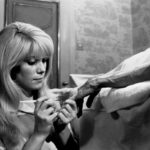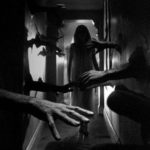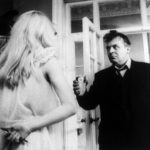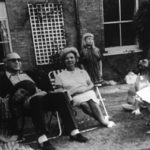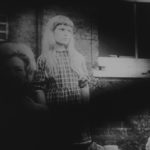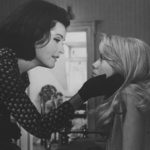You know when you see a film called Repulsion that it’s not going to be wine and roses, nor an altogether pleasant viewing experience, all the more so when the director is Roman Polanski. Whatever his notoriety, Polanski has the knack more than almost any other director (with the possible exception of David Lynch) of taking audiences out of their comfort zone. Not necessarily horror films, but capable of doing something to your head, unsettling you, making you feel ill at ease.
Sure he’s also made narratives in other styles too (Chinatown, The Pianist, Tess and many more) Not all of his movies have been great, but when he is on song Polanski is little short of genius. I first experienced this at about 11 or 12, alone in the house and watching Rosemary’s Baby on TV, after which I was terrified to go upstairs alone. The same was true when I first saw The Tenant a few years later, but the movie that struck me as the apogee of Polanski’s art was Repulsion, made in 1965 and his first English language movie.
Usually described as a psychological horror film, visually influenced by early surrealist cinema, but in essence describes the descent into madness and hallucination of Carol Ledoux (Catherine Deneuve), a young Belgian woman living with her elder sister in London. It is most certainly NOT helped by the strapline dreamed up by a studio marketeer:
“The nightmare world of a virgin’s dreams becomes the screen’s shocking reality.”
While this may have attracted entirely the wrong sort of audience, the film itself offers no compromises, but leaves its own thesis with ambiguous hints but no definitive rationale for Carol’s behaviour. From Wikipedia:
It explores the repulsion Carol feels about human sexuality and the repulsion her suitors experience when they pursue her. The movie vaguely suggests that her father may have sexually abused her as a child, which is the basis of her neuroses and breakdown. Other critics have noted Carol’s repeated usage of items related to her sister’s boyfriend Michael, as well as noting that his presence greatly provokes Carol at the beginning of the film. The film also approaches the theme of boundary breaking, with Tamar McDonald stating that she saw Carol as refusing to conform to the expected “path of femininity”
At the time, Repulsion was very unusual in having a female killer, though both killings are to fight off the unwanted advances of a man. In 1965 the film was almost unique in its study of the psychology of a person driven to those lengths – alongside Hitchcock‘s Spellbound and Psycho, and Michael Powell‘s Peeping Tom – though an industry of this style of psychological analysis has grown into its own sub-genre.
No doubt the film could be psychoanalysed at length, but to Joe Public the impact is disturbing, all the more so because of the ambiguity. We see the impact of her hallucinations complete with Freudian imagery, bizarre dreams, weird tricks being played with the space, her increasingly frenzied and murderous reaction to men, even the skinned rabbit she leaves to decay – but never at any point can we truly feel her emotions are clear and fully defined. She says almost nothing.
Of course, for this to work we have to begin with a credible scenario before this appalling transformation, and so it is. Carol works as a manicurist at the same salon as her sister; it bores her and makes her want to escape. She is intensely shy, uneasy in crowds, does not invite admirers and hates the sound of her sister Helen’s sexual adventures. Even in this relatively steady state, everything is not well with Carol: we see her tics and gestures, sweeping imaginary detritus from her clothes, but the real issues arise when Helen and Michael go on holiday to Italy and she is left alone in the flat.
Worth saying at this point that although the cinematography was primarily done to match the low budget, a single camera shot in black and white is very effective at conveying the claustrophobia of the flat and the sharp relief of sequences shot in very low light. The effect is edgy and menacing – contrasting strongly with the external shots of London in the swinging 60s, with cool and funky music. Shots of road digging and a minor car accident are there – and even a trio with a banjoist and two players of the spoons making two appearances.
Much of the film is recorded in silence as the camera slowly follows her around in close-up, pruriently perusing items in her eyeline, noting what she ignores, looking deep into her expressionless face, noting the fear in her eyes when men come close or talk to her. They don’t understand, and certainly don’t know the horror of the dreams where she is raped by an unseen male figure.
Included but not commented upon is Carol sitting at a bench over a big crack in the concrete, as if she identifies with it. This metaphor continues as the walls of the flat crack in her hallucination, observed by Carol though she takes no action. The walls expand and the hall wall ripples like putty and a forest of arms and hands protrude through to touch her face, to hold her breasts, to take advantage of her. Everywhere she looks there is torture.
Another common theme is the sound from another flat of a pianist practising (badly) – which metaphor is also used in The Tenant. This is a parallel London where every sight and sound betrays menace and danger – you never know what will turn against you, and we are looking from Carol’s point of view.
But then Helen and Michael return and the horror is discovered… the camera lingers on the effects in the living room, then settled on the family photo. We see the little blonde girl, her face turned to her left and looking daggers at her father. Rarely can a film have ended on such a haunting image. The past from which her traumas arise you can only imagine – and imagination is what drives fear. The true horror of Repulsion is not that which happens, not the sheer wanton blood lust but the fear and neuroses from the past that we all recognise – that which goes to our deepest and most distant memories.
Repulsion is a film that lives long in the memory, one that inspired a generation of horror films.



